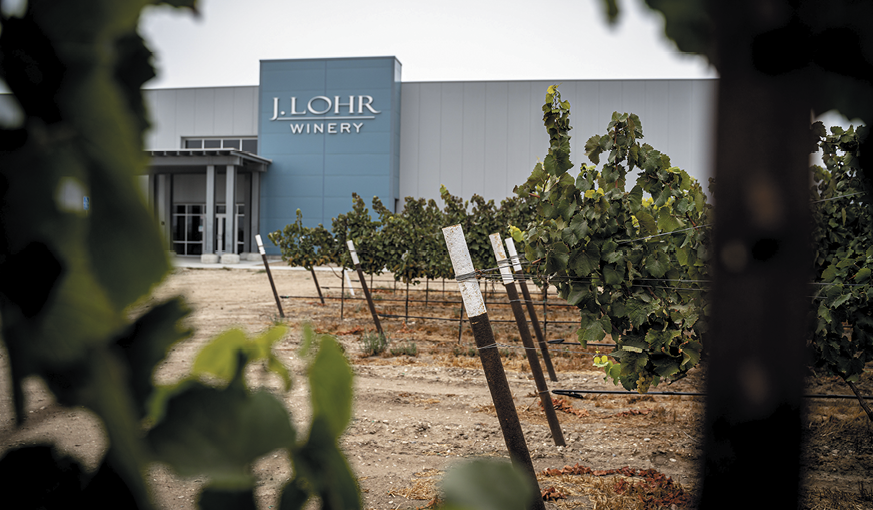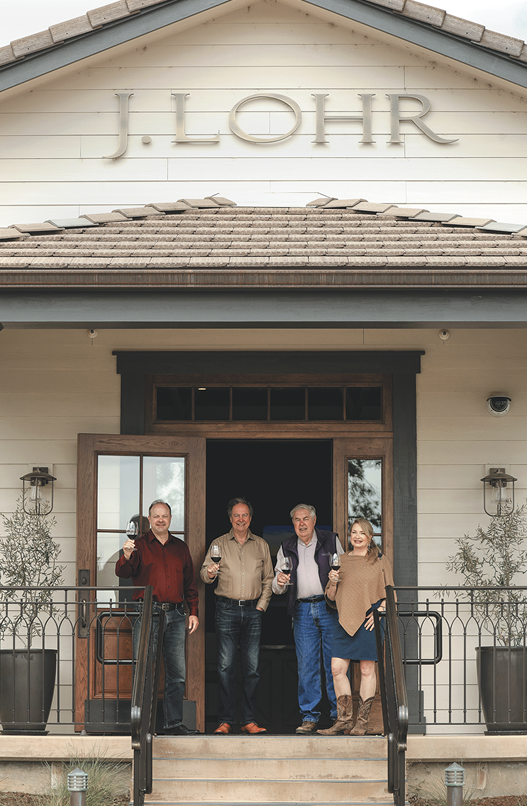


April 9, 2024
LEADERS Magazine
April, May, June 2024 Issue
View the full article here
EDITORS' NOTE
As President and CEO, Steve Lohr is responsible for the overall management and strategic planning of J. Lohr Vineyards & Wines, with a particular focus on sales and finance. In 1972, at the age of 10, Lohr helped his father, Jerry, plant the family’s first vineyards in Greenfield, in what was to become the Arroyo Seco appellation of Monterey County. From that point through high school, he often spent weekends working with his father in the vineyards and learning about wine growing, which fostered his lifelong passion for the industry. After graduating from Stanford University with degrees in civil engineering and economics, Lohr split his time between wine growing, and designing and building high-end custom homes on the San Francisco Peninsula. In 2003, Lohr wrapped up his flourishing custom home building career at the height of the building boom to devote his full energy to J. Lohr Vineyards & Wines as the company’s Vice President of Planning and Development. In 2009, Lohr was named Executive Vice President and Chief Operating Officer for J. Lohr Vineyards, and for the next four years oversaw the management and development of J. Lohr’s vineyards in Paso Robles, Monterey County, and St. Helena. In 2013, he was promoted to Chief Executive Officer of J. Lohr Winery and added the title of company President in 2021. Lohr completed a three-term chairmanship of the Paso Robles Wine Country Alliance in 2009 and continues to advocate on behalf of the appellation and its 200+ wineries; in 2018, the Alliance named him its Wine Industry Person of the Year. Recognizing the importance of sustainability to a multigenerational family business, Lohr chairs J. Lohr’s internal Sustainability Committee, and sits on the Board (and was the Chairman from 2016-18) of the California Sustainable Winegrowing Alliance, which promotes the adoption of sustainable practices throughout California’s vineyards and wineries. A longtime Board member of Wine Institute, he served as an officer of the organization for five years, and was its Chairman in 2017-18, bringing together the resources of 1,000 wineries and affiliated businesses to support legislative and regulatory advocacy, international market development, media relations, scientific research, and education programs that benefit the entire California wine industry.
WINERY BRIEF
Fifty years ago, the California Central Coast had not yet emerged as one of North America’s world-class wine-growing regions. With little history or viticultural precedent, planting on the Central Coast was a gamble. One of a handful of early pioneers, Jerry Lohr, was among the first to realize the inherent potential of Monterey and Paso Robles for growing high-quality grapes and producing superb wines. J. Lohr Vineyards & Wines (jlohr.com) now includes more than 1,400 acres of cool-climate estate vineyards in the Arroyo Seco and Santa Lucia Highlands regions of Monterey County, with an emphasis on Chardonnay, Riesling, Valdiguié, and Pinot Noir. J. Lohr farms over 2,700 acres of vineyards in Paso Robles, now recognized as one of the world’s best spots for Cabernet Sauvignon and other Bordeaux and Rhone varietals. Nearly all the red wines in the J. Lohr portfolio come from there, affirming the foresight of Jerry Lohr’s original vision. The winery also owns 30+ acres in Napa Valley at its spectacular Carol’s Vineyard, planted to Cabernet Sauvignon and Petit Verdot. J. Lohr has state-of-the art winemaking facilities in Greenfield and Paso Robles. The J. Lohr Wine Centers in San Jose and Paso Robles host thousands of visitors and fans each year.
.png)
Will you discuss the history of J. Lohr Vineyards & Wines?
Half a century ago, my father, Jerry Lohr, played a significant role in putting the Paso Robles and Monterey County’s Arroyo Seco regions on the wine map – establishing himself, and J. Lohr Vineyards & Wines, as a leading proprietor of discovery and innovation in California’s Central Coast. In the early 1970s, Jerry chose the Arroyo Seco for his initial vineyard plantings of 280 acres. I was fortunate enough to help plant those vineyards as a little boy. Jerry and his team soon discovered that the Arroyo Seco’s windy climate and rocky soils were ideal for cool-climate varieties. Today, the Arroyo Seco AVA is known for producing complex Chardonnay and Pinot Noir with trademark fruit intensity and balancing acidity. Jerry also recognized early on the potential of Paso Robles for growing the traditional Bordeaux varieties, particularly Cabernet Sauvignon. In 1986, the J. Lohr team began planting Cabernet Sauvignon in Paso Robles to harness the area’s diverse soils and take advantage of its ideal diurnal temperature swings. The J. Lohr Vineyards & Wines’ Paso Robles winery and production facility soon followed in 1988.
Today, J. Lohr is still family-owned and operated by my two siblings, Cynthia and Lawrence, and me. Our motto, “Family, Place, and Craft,” illustrates our family and team’s passion for every step of the winegrowing process, from soil to bottle.
Will you provide an overview of J. Lohr’s offerings?
Today, J. Lohr owns more than 1,400 acres of estate vineyards in Monterey County’s Arroyo Seco and Santa Lucia Highlands regions, growing Chardonnay, Sauvignon Blanc, White Riesling, Valdiguié, Pinot Noir, and Pinot Blanc. In Paso Robles, the company farms over 2,800 acres of vineyards, specializing in Cabernet Sauvignon and the other Bordeaux varieties and several Rhône cultivars. J. Lohr also owns 30+ acres in Napa Valley, planted to Cabernet Sauvignon and Petit Verdot.
J. Lohr has achieved Jerry’s founding vision of crafting a selection of tiered wines that deliver exceptional quality and value. Our wines are strong expressions of the Central Coast’s vineyards, climate, and terroir, are approachable yet sophisticated, and are the perfect complement to most any meal.

What can guests expect to experience when visiting the J. Lohr winery?
Nestled amidst picturesque vineyards in a captivating farmhouse setting, guests will embark on an extraordinary journey upon arrival at the J. Lohr Paso Robles Wine Center, where they’ll be presented with a diverse array of immersive tasting experiences. Additionally, guests are welcome at the J. Lohr San Jose Wine Center, an urban oasis gracing historic downtown San Jose.
Guests can enjoy an array of offerings at both locations including tastings, wine and food pairings, and exclusive club events, all carefully curated to elevate your senses and deepen your appreciation for the world of wine.
What have been the keys to the strength and leadership of J. Lohr for over five decades?
As with many companies, our people are our greatest asset. Many of our folks have been with us for 20 to 30+ years and are leaders in their fields. Owning and managing our own vineyards allows us to produce wines of exceptional quality with incredible consistency and value from vintage to vintage. Whereas we do buy some grapes from other top growers, the great majority of the grapes in any bottle of J. Lohr wine come from our own vineyards, and all the wine is produced by us. We are fortunate to be financially strong and stable so that we can make the correct decisions for the long term and the health of our brand.
When you plant a vineyard, you are making decisions that will impact your business for the next 25-30+ years; wineries are very capital intensive with their specialized structures, presses, stainless steel tanks, and oak barrels. Thus, you want to protect and grow that investment by actively shaping industry policy, and we have served on the boards and chaired organizations such as Wine Institute and California Association of Winegrape Growers; marketing and technical groups such as Paso Robles Wine Country Alliance and Monterey County Vintners & Growers Association; and sustainability organizations such as California Sustainable Winegrowing Alliance and the Vineyard Team.
The industry and public have been good to us, so we have responded by providing thought and financial leadership to the University of California, Davis, with the world’s first LEED Platinum certified winery. In addition, Cal Poly San Luis Obispo now has state of the art winemaking facilities at their Lohr Family Winery.

Will you discuss J. Lohr’s commitment to sustainability?
J. Lohr was an early adopter of sustainable practices, contributing to the development of industry-wide green methods and certifications. Sustainability at J. Lohr is a fundamental company-wide value embraced by the Lohr family and incorporated into every department’s operations.
We planted J. Lohr Vineyards & Wines’ first estate vineyards in Paso Robles using sustainable practices in 1986. In 2008, I established an internal Sustainability Committee, and in 2010, J. Lohr became one of the first 17 vineyards and wineries in the state to receive the Certified California Sustainable Winegrowing distinction from the California Sustainable Winegrowing Alliance (CSWA). By diligently adhering to the rigorous, audited 249 best practices and 101 prerequisites in the Code of Sustainable Winegrowing Practices Self-Assessment Workbook, J. Lohr has maintained its process certification for all its vineyards and wineries every year.
In 2020, J. Lohr received the ultimate sustainability award in the grape and wine industry, the Green Medal Leader Award from the California Sustainable Winegrowing Alliance for balancing environmental, economic, and social goals and integrating sustainability into every aspect of its business. Today, 28 individual J. Lohr wines carry the Certified California Sustainable seal (product certification) on our back labels.
J. Lohr integrates three pillars of sustainability – social equity, environmental responsibility, and economic feasibility – into every aspect of our family’s company operations.
What has made the wine industry so special for you?
The wine industry includes some of the friendliest people you will ever meet. Although it is extremely competitive with over 5,000 wineries in California and another 5,000 wineries in the 49 other states, no one will have your exact same soil or climate, so the industry shares a lot of ideas and thrives on half science and half art, both of which are better when they are shared. Our sole reason for being is to make people happy – to add enjoyment to their celebrations as well as a weeknight dinner.
I love variety in my daily work. With planning and oversight needed for vineyards, production, sales, marketing, finance, and hospitality, no two days are the same and there is plenty to keep me focused. I also really enjoy the fact that there is not another agricultural product in which the decisions you make can so profoundly affect the ultimate quality of what you are producing, in this case a wine grape or a bottle of wine.
It is also a sheer joy to be able to work so closely with my father Jerry (Founder and CFO), sister Cynthia (Chief Brand Officer), and brother Lawrence, (President and COO, J. Lohr Vineyards, Inc.), along with 260 of the best and brightest on our J. Lohr team.
As J. Lohr celebrates its 50th anniversary, are you able to take moments to reflect on J. Lohr’s legacy and the impact that J. Lohr has made in the industry?
We have worked hard to bring the Central Coast of California to prominence, particularly Paso Robles and Monterey. Several years ago when Wine Enthusiast magazine honored our father with the very rare American Wine Legend award, they noted that “Jerry Lohr is to the Central Coast what Robert Mondavi was to Napa Valley,” It’s so important to us that we continue to advance the state of grape growing and winemaking knowledge not only within J. Lohr, but throughout the industry, so that current and future generations can benefit from what we have been able to learn and achieve over these first 50 years